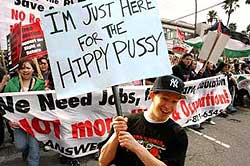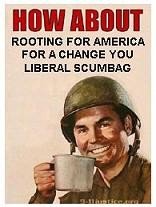We've heard of the magical high-speed rail proposal, right? Proposition 1A? This is a really bad idea, writ really large. And it's a scam. People need to understand that:
1) This state does not have money to waste. We only dug out of the latest budget impasse with a shift in how early people have to pay their taxes. You can rest assured that next year we will be in the same position, but without that gimmick to use again.
2) BONDS ARE NOT FREE MONEY!!! Man, that is a frustrating point to try and get across. How blind do people have to be to the headlines to understand that leveraging your future on credit is a bad idea? If we don't have ten billion to spend today, we also don't have twenty billion to pay back over the next 30 thirty years, starting next year as a 2/3 billion dollar annual dip into the general fund just for this one bond. Let me restate that: If this passes, there will be 2/3 of a billion dollars added to required state spending starting next year that will not go away for thirty years! Well, at least we're off the hook in thirty years, right? Well, actually, that's about the point at which major rehabilitation and rebuilding costs will kick in...
3) But, nevermind that we can't afford ten billion, because the ten billion isn't even the whole admitted cost of this thing! Even the lowball initial estimate of the project (before we are hooked into this and stuck paying whatever budget overruns occur) is $45 billion. Where do proponents hope to get the other $35 billion? Magic fairies? Well, almost. Back when the dreamland figure was 'only' $25 billion, the idea was that the private companies who will take care of day-to-day operations will pony up $5 billion, which is dubious at this point. Meanwhile, the remaining $10 billion was supposed to come from the federal government. When I say, "supposed to come from", I mean that is the totally unsubstantiated wish of the project backers. The Congress has absolutely not voted to send $10 billion dollars our way. Nor should they. As broke as the California state government is, the fed is even broker. Moreover, we aren't the only ones dreaming of laying our infrastructure finances on the tracks in front of an oncoming train. Similar boondoggles are afoot in other states and the federal government can't fund our bad idea unless they agree to fund every other bad idea, too. To them, our $10 billion plea looks like a $60 or $70 billion dollar commitment to the states that are being sold this high-speed rail bill of goods. And that's before bailing out rail programs from inevitable cost-overruns and the fact that states won't be able to get business partners to pour money into this sewer.
4) So, the unaffordable $10 billion dollar project is really a really unaffordable $45 billion dollar project that would still need another $35 billion in mystery money, right? Not exactly. This project will cost way more than even the $45 billion. With cost overruns that are absolutely typical of these projects, we are looking at about a $65 billion dollar project. Look up the cost overruns in Boston's Big Dig project, which was initially supposed to cost about $6 billion In 2006 dollars) but wound up costing over 14 billion. The 1A project is way bigger than the Big Dig - it would be the biggest construction project ever taken on by any state. That leaves even more room for cost overruns.
That's not a worst case scenario. That's the realistic low number. Period. And, don't count on the federal government or private businesses deciding to flush the extra $50 billion down this toilet. We will pay for it ourselves, with even more bonds, leading to even higher taxes, and politicians whining that businesses and high-income residents are leaving the state because they are such meanies for not sticking around to pick up the tab for every dumb idea that sweeps through the state.
5) The plans don't even specify where to lay the tracks yet. That's right: there isn't even agreement on where this monstrosity should cross over from the Bay Area to the Central Valley. That will affect costs, construction time, ticket prices, transit time, and ridership.
6) The primary business case for this system is already dead. The sales pitch for this plan was that it would replace the LA-SF air traffic by making a Northern California to Southern California trip "commutable" (apologies to math majors). In other words, the trip would be like a long commute, something inconvenient but doable on a frequent basis. One could, in theory, head toward a train station at one end at a reasonable time in the morning, zip to the other end in a couple hours, have a productive day of business meetings and so on, then zip back and get home by dinner. Well, that works if the time wasted ticketing and boarding is just a few minutes and the actual trip is two hours or so, maybe two-and-a-half. But that isn't going to happen. Realistically, the trip will be well over three and a half hours. That's right. The trip is now not commutable and has become the pain-in-the-ass red-eye trip or an overnighter that will keep business travelers in the sky. So much for relieving air traffic at LAX and SFO.
Oh, and the arguments that it will be so convenient - no waiting in flip flops to be X-rayed while TSA pokes through your laptop and checks that you don't have a full-sized water bottle - are utter baloney. There is no way that a high-profile, tens-of-billions-of-dollars rail system, with hundreds of passengers on it, moving at speeds that would make a spectacular crash, will not be a terrorist target. And, there is no way there aren't going to be TSA goons making sure you aren't sneaking any deadly, deadly nail clippers on board. If you think that's not the case, you are living in a dreamland.
BTW, all that extra security at the station will mean nothing, because there will be hundreds of miles of unguardable track. To a terrorist, that still equals a spectacular crash, but without the inconvenient suicide.
7) HSR invites a nightmare of urban planning and government control of private property development. Make no mistake: Every city with a rail station or hopes of getting one will now have an incentive to "plan" private property development so that everything is rail accessible. The state will come up with another "matching fund" gimmick to encourage cities to do just that, complete with a commission to evaluate whether a city's rail access development plan meets the visions of the geniuses in Sacramento. Were you hoping to get permits to put a couple retail stores on a lot you own? "Sorry. Permits are scarce unless you are on the tram route to and from the rail station. Why don't you rent some retail space in the new Rail Mall? Golly, those well-connected guys made a mint developing that empty field and they always seem to be able to get approval for new development!" Does your community need the city to add a couple lanes to the local highway to alleviate traffic snarls? "Sorry. Our resources are focused on redesigning downtown to make it more rail-friendly."
The one advantage of this is that it will serve to highlight the inadequacy of the eminent domain "reform" the planning commissions snuck through this last Spring. If you live in a rail city or a rail-hopeful city, your property rights will be seen just as an obstacle to those trying to design a rail utopia.
8) But, spending all that money that we don't have will create thousands of jobs in California, right? Don't be silly. Even ignoring the interests costs here, the old New Deal hokum that we can borrow ourselves to economic prosperity has been something of a joke among economists outside political circles and it's no different here. The problem is that that borrowed money has to come from somewhere and it comes from investors who would otherwise be lending it to projects with more direct economic value. In other words, that money the state borrows is coming largely from money that would otherwise be available to entrepreneurs and private companies looking to expand their businesses. The state gobbling up that money makes it harder for those businesses to grow.
Meanwhile, the higher taxes needed to pay back the 1A bond loans will necessarily make it less attractive for businesses to locate here in California. I sure hope the people who vote for this understand that when we suffer sluggish growth as businesses and high-income earners look to locate in states that don't punish them as much as we do.
Anyway, that's government-run high-speed rail in short. Kids play with trains. Good for them. The rest of California needs to grow up and stop throwing money it doesn't have at pie-in-the-sky projects that won't fix actual problems.











2 comments:
You're right.
Trains bad!
Government bad!
Drive more cars!
Build more roads!!
...wait -- we will get *private* companies to build the roads, right?
I mean, we won't have to rely on the government to build or maintain them, will we?
Cause that's, like, TOTALLY communistic, right?
And we hate commies and pinkos and people who want to share?
Right?
I'm confused.
Please tell me how to think, and I will be busy playing with my big boy toys: guns, not trains.
Actually, no one said anything against sharing, though that's sort of a common straw man fallacy that pops up when discussing proper scope of government.
And, of course, I didn't say anything about communism or pinkos, either.
I don't want to tear apart every glib comment line-by-line, but the straw man technique is a weak rhetorical device. Just as friendly advice: It's really obvious to any reader when you throw out a pile of nonsense that your opponent hasn't said and proceed to argue against that as though you are refuting his points.
I made some points about the costs and effectiveness of Prop 1A. Obviously, you don't have much to say about those points. And, given how really, really bad Prop 1A is, that's not especially surprising. But, thanks for stopping by.
Post a Comment